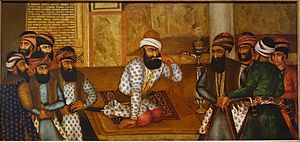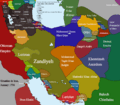Karim Khan Zand facts for kids
Quick facts for kids Karim Khan Zandکریم خان زند |
|
|---|---|
| Vakil-e Ra'aya (Deputy of the People) |
|

Contemporary portrait of Karim Khan Zand.
|
|
| Vakil-e Ra'aya of Iran | |
| Reign | 1751 – 1 March 1779 |
| Successor | Mohammad Ali Khan Zand |
| Born | c. 1705 Pari, Safavid Iran |
| Died | 1 March 1779 Shiraz, Zand Iran |
| Burial | Pars Museum (1779–1796, 1925–present) Golestan Palace (1796–1925) |
| Consorts | Khadijeh Begum Shakh-e Nabat |
| Issue | Mohammad Rahim Abol-Fath Khan Zand Mohammad Ali Khan Zand Ebrahim Khan Saleh Khan |
| Dynasty | Zand dynasty |
| Father | Inaq Khan Zand |
| Mother | Bay Agha |
| Religion | Twelver Shia Islam |
Mohammad Karim Khan Zand (Persian: محمدکریم خان زند, romanized: Mohammad Karīm Khân-e Zand; c. 1705 – 1779) was the founder of the Zand Dynasty. He ruled most of Iran (also known as Persia) from 1751 to 1779. He also controlled parts of the Caucasus region and held Basra for several years.
During Karim Khan's rule, Iran recovered from 40 years of war. He brought back peace, security, and wealth to the country. The years from 1765 until his death in 1779 were the best for the Zand dynasty. He re-established connections with Britain and allowed the East India Company to set up a trading post in southern Iran. Karim Khan made Shiraz his capital and built many beautiful buildings there. He is remembered as one of the most kind Iranian rulers in Islamic history. Even after the Islamic Revolution in 1979, people in Shiraz refused to rename streets named after him.
After Karim Khan died, a civil war started again. None of his family members could rule as well as he did. The last Zand ruler, Lotf Ali Khan, was killed by Agha Mohammad Khan Qajar, who then became the sole ruler of Iran.
Contents
Early Life and Rise to Power
From Humble Beginnings
Karim Beg was born around 1705 in the village of Pari. He belonged to the Zand tribe, a small group of Laks. The Zands lived in the Zagros Mountains and near Hamadan. In 1722, the Safavid Empire was falling apart. Afghan forces took over central and eastern Iran. Meanwhile, Russians and the Ottoman Empire also took parts of the country. The Zand tribe bravely fought against the Ottomans.
In 1732, Nader Shah became the ruler of Iran. He moved many tribes, including the Zands, to Greater Khorasan. Karim Beg and other Zand members joined Nader's army. Karim Beg served as a cavalry soldier. He was not very high-ranking in the army at that time.
Taking Control of Western Iran
Nader Shah was killed in 1747. This gave the Zand tribe, led by Karim Khan, a chance to return to their homeland. In 1750, Karim Khan joined forces with other leaders. They planned to restore the old Safavid dynasty. They captured Isfahan, a major city. A young Safavid prince, Abu Turab, was made a puppet ruler named Ismail III.
Karim Khan was appointed the army commander. However, one of his allies, Ali Mardan Khan, started to act unfairly. He took too much from the people of Isfahan and killed the city's governor. Ali Mardan then marched to Shiraz and looted the province of Fars.
The Fight for Supremacy
When Karim Khan returned to Isfahan in January 1751, he brought order back to the city. A battle took place between Karim Khan and Ali Mardan Khan. During the fight, Ismail III and other leaders joined Karim Khan. Karim Khan won, forcing Ali Mardan to retreat.
Ali Mardan tried to fight back several times. He even allied with other leaders. But Karim Khan defeated him again and again. Eventually, Ali Mardan was forced to flee to Baghdad. Karim Khan slowly gained control over more of western Iran.
Karim Khan's Rule
A New Kind of Ruler
After many battles, Karim Khan, Ali Mardan Khan, and another leader agreed to divide the country. They also agreed to make the Safavid prince Ismail III the king. But Ali Mardan Khan broke the agreement. He invaded Isfahan and killed one of the leaders. Later, Karim Khan killed Ali Mardan Khan. This gave Karim Khan control over almost all of Iran. Only Khorasan, ruled by Nader Shah's grandson, remained outside his control.
Karim Khan chose not to call himself "Shah" (King). Instead, he used the title Vakil e-Ra'aayaa, which means "Representative of the People." This showed his desire to serve his people.
Peace and Prosperity
During Karim Khan's rule, Iran began to heal. The country had suffered from 40 years of war. Karim Khan brought back peace, safety, and wealth. The years from 1765 to 1779 were the most successful for the Zand dynasty. He re-established trade with Britain. He allowed the British East India Company to open a trading post in southern Iran.
Karim Khan made Shiraz his capital. He ordered the building of many new structures there. These included his famous castle, gardens, and mosques. He also had a new city wall, baths, a caravanserai (a roadside inn), and a bazaar built. Many of these buildings were later destroyed.
Karim Khan also renovated the tombs of important figures. These included the ruler Shah Shoja Mozaffari and the famous poets Hafez and Saadi. Many families from the Lur and Lak tribes moved to Shiraz. The city grew to have a large population. It attracted poets, craftsmen, and traders from Europe and India.
War with the Ottoman Empire
In 1774, the Ottoman governor of Iraq, Omar Pasha, caused problems. He interfered with a local principality and demanded money from Iranian pilgrims visiting holy Shia sites. This gave Karim Khan a reason to declare war on the Ottomans.
In April 1775, Karim Khan's forces, led by Sadeq Khan, besieged Basra. Basra was an important trading port. The siege lasted over a year. Despite some help from Oman and Baghdad for Basra, Sadeq Khan's forces kept fighting. The defenders eventually ran out of food. On April 16, 1776, Basra surrendered to Karim Khan's army.
Karim Khan died on March 1, 1779, after being sick for six months. He was likely suffering from tuberculosis. He was buried three days later in the "Nazar Garden," which is now the Pars Museum.
Legacy and Character
Karim Khan is often praised for being generous, humble, and fair. Many stories show him as a kind ruler who truly cared about his people. Even today, Iranians remember him as a respected leader. He was not ashamed of his humble background. He never tried to pretend he came from a more important family.
Karim Khan preferred simple clothes and furniture. He wore a tall yellow Zand turban and sat on a simple carpet instead of a throne. He even sold expensive jewels to keep the state's money stable. He was known for his simple lifestyle.
During his rule, Karim Khan brought unexpected good fortune and peace to Iran. The country had suffered greatly before him. His mix of energy, ambition, wisdom, and kindness created a balanced and good state. This was remarkable for a difficult and chaotic century.
Historian John Malcolm described Karim Khan's rule as a "mixed pleasure and repose." He said it was like finding a beautiful valley after a hard journey. Karim Khan gained power without committing crimes and used it with great moderation, humanity, and justice.
Government and Society
How the Country Was Run
Karim Khan kept the government small. He had a chief minister (vizier) and a chief tax officer. But Karim Khan handled most political matters himself. This meant these officials had little power.
The way provinces were governed was similar to the Safavid era. Governors were appointed to lead provinces. Cities had a kalantar and a darugha, while neighborhoods had a kadkhuda. Most governors were tribal leaders from Fars. Karim Khan also created new roles for tribes. He appointed an ilkhani for all Lur tribes and an ilbegi for all Qashqai tribes in Fars.
The Army
Karim Khan had a strong army. It included cavalry (soldiers on horseback) and infantry (soldiers on foot). Many of his soldiers came from different tribes like the Lurs, Kurds, and Bakhtiaris.
| Karim Khan's Army in Fars (1765–1775) | Number of Soldiers |
|---|---|
| Lur, Kurd (cavalry) | 24,000 |
| Bakhtiari (cavalry and infantry) | 3,000 |
| From Persian Iraq (Persian infantry) | 12,000 |
| From Fars and Khuzestan (Persian infantry, Arab and Iranian cavalry) | 6,000 |
| Total | 45,000 |
Images for kids
-
An illustration of Isfahan from the south.
-
Gold coin of Karim Khan Zand, minted in Isfahan, dated 1755/6
-
Gold coin of Karim Khan Zand, minted in Tabriz, dated 1773/4
-
Karim Khan Zand with the Ottoman envoy Vehbi Efendi.
-
Picture of the Arg of Karim Khan, the royal residence of the Zand dynasty.
See also
 In Spanish: Mohammad Karim Jan para niños
In Spanish: Mohammad Karim Jan para niños









